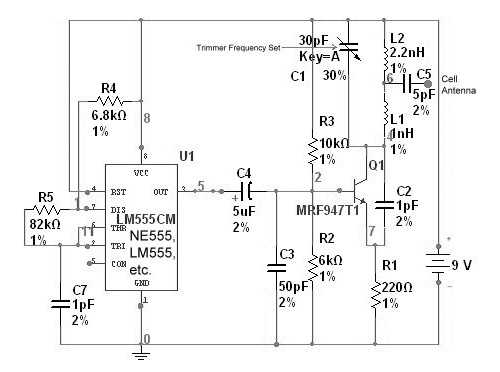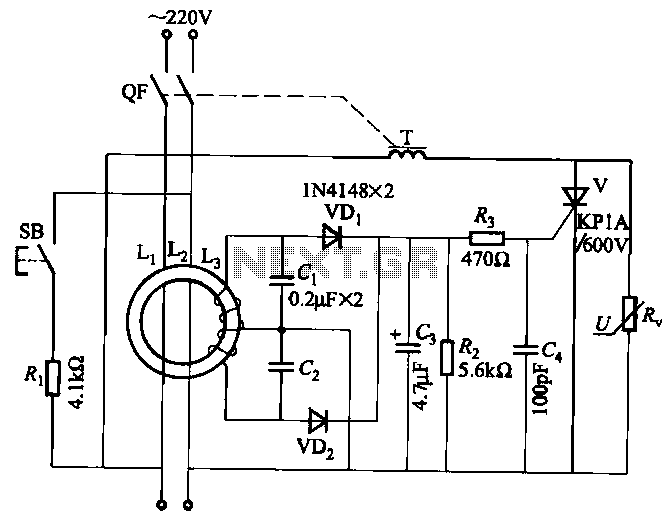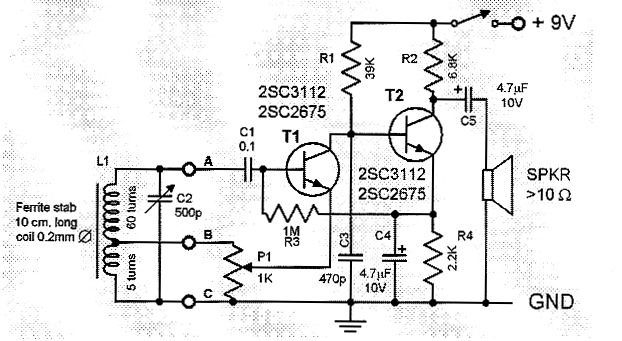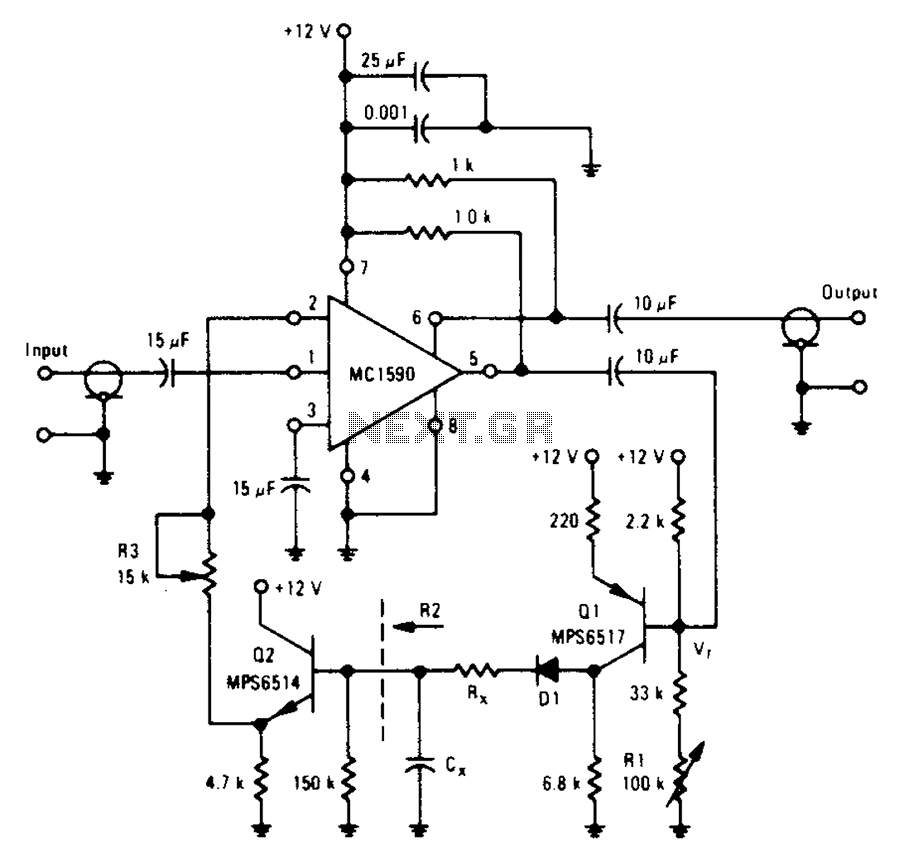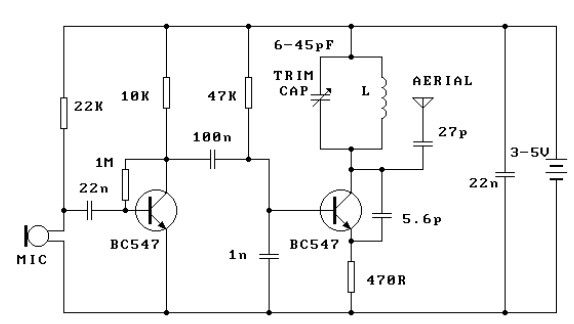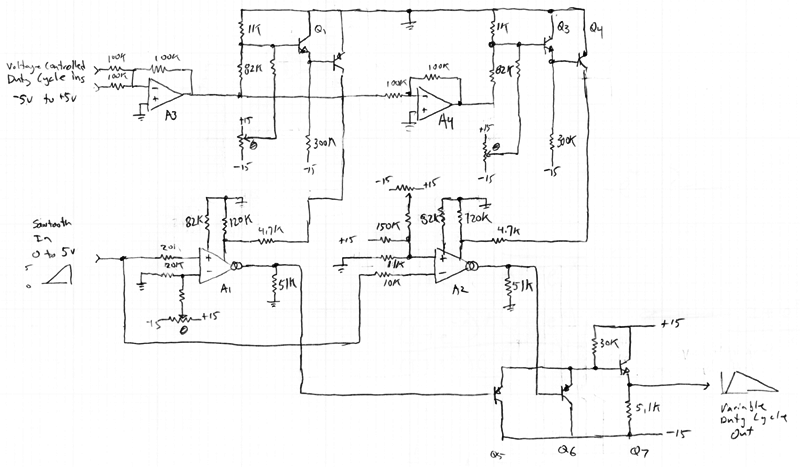
Dc Output Chopper Circuit
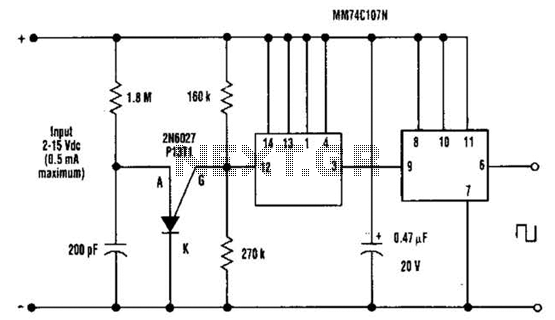
A direct current (DC) voltage source within the range of 2 to 15 volts can be converted into a unipolar square wave. This square wave has a peak amplitude that is nearly equal to the DC source voltage, with lightly loaded complementary metal-oxide-semiconductor (CMOS) circuits swinging within a few millivolts of each rail at low frequencies. The programmable unijunction transistor (PUT) relaxation oscillator generates trigger pulses at a frequency of 2000 Hz, depending on the actual voltage of the supply. These pulses are utilized to operate a cascaded 74C107 flip-flop, which produces the square wave output.
The described circuit utilizes a DC voltage source, which serves as the input for the conversion process. The unipolar square wave generated from the DC voltage is characterized by its peak amplitude closely matching the input voltage, making it suitable for various applications requiring a square wave signal. The lightly loaded CMOS configuration ensures that the output remains stable and exhibits minimal voltage drop, thus maintaining signal integrity.
The relaxation oscillator, implemented with a programmable unijunction transistor (PUT), functions as the core timing element of the circuit. The frequency of the generated trigger pulses is set at 2000 Hz, which can be adjusted based on the supply voltage. This frequency is critical for applications that require precise timing and synchronization.
The cascaded 74C107 flip-flop plays a pivotal role in shaping the output waveform. This dual D-type flip-flop configuration allows for the generation of a square wave signal, effectively transforming the trigger pulses from the PUT into a coherent output. The output from the flip-flop can be utilized in various digital applications, including signal processing, clock generation, and timing circuits.
Overall, this circuit demonstrates an efficient method of converting a DC voltage source into a square wave signal, leveraging the capabilities of a PUT and a 74C107 flip-flop to achieve reliable and precise output characteristics. Any dc voltage source in the 2- to 15-V range can be chopped into a unipolar square wave that has a peak amplitude nearly equal to the dc source voltage-with circuit (lightly loaded CMOS will swing within a few millivolts of each rail at low frequencies). Depending on the actual voltage of the supply, the programmable-unijunction-transistor (PUT) relaxation oscillator produces 2000-Hz trigger pulses.
These pulses operate the cascaded 74C107 flip-flop, producing a square wave. 🔗 External reference
The described circuit utilizes a DC voltage source, which serves as the input for the conversion process. The unipolar square wave generated from the DC voltage is characterized by its peak amplitude closely matching the input voltage, making it suitable for various applications requiring a square wave signal. The lightly loaded CMOS configuration ensures that the output remains stable and exhibits minimal voltage drop, thus maintaining signal integrity.
The relaxation oscillator, implemented with a programmable unijunction transistor (PUT), functions as the core timing element of the circuit. The frequency of the generated trigger pulses is set at 2000 Hz, which can be adjusted based on the supply voltage. This frequency is critical for applications that require precise timing and synchronization.
The cascaded 74C107 flip-flop plays a pivotal role in shaping the output waveform. This dual D-type flip-flop configuration allows for the generation of a square wave signal, effectively transforming the trigger pulses from the PUT into a coherent output. The output from the flip-flop can be utilized in various digital applications, including signal processing, clock generation, and timing circuits.
Overall, this circuit demonstrates an efficient method of converting a DC voltage source into a square wave signal, leveraging the capabilities of a PUT and a 74C107 flip-flop to achieve reliable and precise output characteristics. Any dc voltage source in the 2- to 15-V range can be chopped into a unipolar square wave that has a peak amplitude nearly equal to the dc source voltage-with circuit (lightly loaded CMOS will swing within a few millivolts of each rail at low frequencies). Depending on the actual voltage of the supply, the programmable-unijunction-transistor (PUT) relaxation oscillator produces 2000-Hz trigger pulses.
These pulses operate the cascaded 74C107 flip-flop, producing a square wave. 🔗 External reference
Warning: include(partials/cookie-banner.php): Failed to open stream: Permission denied in /var/www/html/nextgr/view-circuit.php on line 713
Warning: include(): Failed opening 'partials/cookie-banner.php' for inclusion (include_path='.:/usr/share/php') in /var/www/html/nextgr/view-circuit.php on line 713
